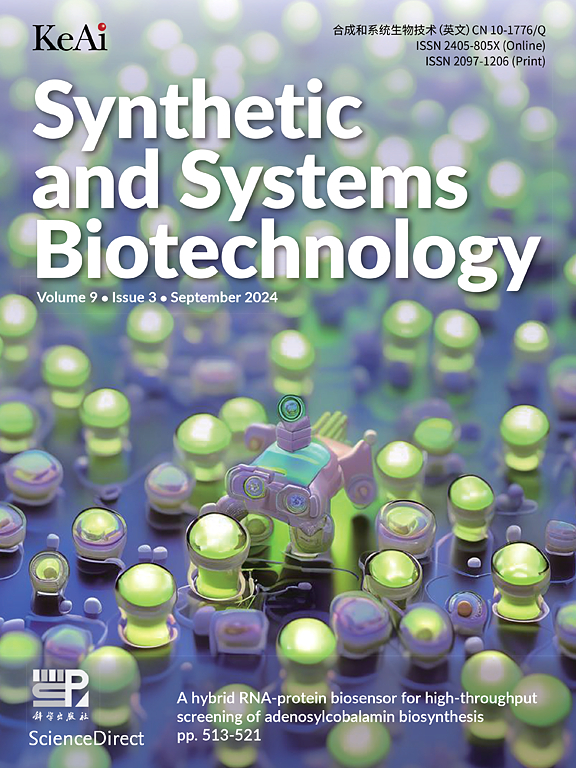利用代谢和酶工程技术高效生产多脂耶氏菌虾青素
IF 4.4
2区 生物学
Q1 BIOTECHNOLOGY & APPLIED MICROBIOLOGY
引用次数: 0
摘要
虾青素是一种天然的红色类胡萝卜素,由于其显著的抗氧化作用,通常用作制药工业的添加剂和营养补充剂。然而,复杂的生物合成途径对虾青素的重新生物合成提出了挑战。在这里,脂质体耶氏菌通过多种策略进行工程设计,使用廉价的矿物培养基实现虾青素的高水平生产。为了生产β-胡萝卜素,构建了一个平台菌株,在摇瓶水平上生产411.7 mg/L的β-胡萝卜素。藻类β-胡萝卜素酮化酶和β-胡萝卜素羟化酶的整合使虾青素的产量达到12.3 mg/L。此外,HpBKT和HpCrtZ作为单一酶复合物的构建以及酶的催化活性增强导致虾青素的积累为41.0 mg/L。基因在基因组中的迭代整合和虾青素生产途径向亚细胞器方向的转变大大增加了虾青素的产量(172.1 mg/L)。最后,恢复营养不良标志物和培养基优化进一步提高虾青素产量至237.3 mg/L。采用上述方法进行分批补料发酵,虾青素产量为2820 mg/L(比发酵剂提高229倍),平均产量为434 mg/L/d,葡萄糖产量为5.6 mg/g,这是脂肪瘤菌中报道的最高产量。本文章由计算机程序翻译,如有差异,请以英文原文为准。

Efficient production of astaxanthin in Yarrowia lipolytica through metabolic and enzyme engineering
Astaxanthin is a natural red carotenoid, commonly used as an additive in the pharmaceutical industry and as a nutritional supplement owing to its notable antioxidant benefits. However, a complex biosynthetic pathway poses a challenge to de novo biosynthesis of astaxanthin. Here, Yarrowia lipolytica was engineered through multiple strategies for high level production of astaxanthin using a cheap mineral medium. For the production of β-carotene, a platform strain was constructed in which 411.7 mg/L of β-carotene was produced at a shake-flask level. Integration of algal β-carotene ketolase and β-carotene hydroxylase led to the production of 12.3 mg/L of astaxanthin. Furthermore, construction of HpBKT and HpCrtZ as a single enzyme complex along with the enhanced catalytic activity of the enzymes led to the accumulation of 41.0 mg/L of astaxanthin. Iterative gene integration into the genome and direction of the astaxanthin production pathway into sub-organelles substantially increased astaxanthin production (172.1 mg/L). Finally, restoration of the auxotrophic markers and medium optimization further improved astaxanthin production to 237.3 mg/L. The aforementioned approaches were employed in fed-batch fermentation to produce 2820 mg/L of astaxanthin (229-fold improvement regarding the starter strain), with an average productivity of 434 mg/L/d and a yield of 5.6 mg/g glucose, which is the highest reported productivity in Y. lipolytica.
求助全文
通过发布文献求助,成功后即可免费获取论文全文。
去求助
来源期刊

Synthetic and Systems Biotechnology
BIOTECHNOLOGY & APPLIED MICROBIOLOGY-
CiteScore
6.90
自引率
12.50%
发文量
90
审稿时长
67 days
期刊介绍:
Synthetic and Systems Biotechnology aims to promote the communication of original research in synthetic and systems biology, with strong emphasis on applications towards biotechnology. This journal is a quarterly peer-reviewed journal led by Editor-in-Chief Lixin Zhang. The journal publishes high-quality research; focusing on integrative approaches to enable the understanding and design of biological systems, and research to develop the application of systems and synthetic biology to natural systems. This journal will publish Articles, Short notes, Methods, Mini Reviews, Commentary and Conference reviews.
 求助内容:
求助内容: 应助结果提醒方式:
应助结果提醒方式:


